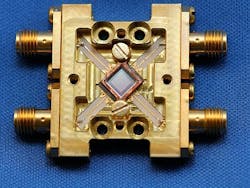Huge Tanzanian helium gas field will help rescue cryogenic science and technology
The world's supply of helium—used in MRI scanners, welding, industrial leak detection, the nuclear energy industry, and all across the areas of science and high technology, including photonics—has been getting low, with known reserves quickly running out. And conventionally, sources of helium could never be found intentionally, instead being accidentally discovered in small quantities during oil and gas drilling.
Used to cool photonics down to 4 K, thus decreasing noise of thermal origin to very low levels, liquid helium is often used in now-noise photon detection, as in a superconducting focal-plane array that spans UV to near-IR, superconducting nanowire single-photon detectors (SNSPDs), and terahertz-radiation detection, as well as some cryogenic emitters such as a high-peak-power pulsed terahertz quantum-cascade laser. In its gaseous form, helium is part of the gain medium for helium-neon and helium-cadmium lasers, is used for cooling of certain systems such as Lawrence Livermore National Laboratory's (LLNL's) Mercury laser for inertial-confinement fusion, and can be a cavity fill gas for continuous-wave cavity ringdown spectroscopy. (Note: "cryogenic" does not necessarily mean liquid-helium-cooled. The majority of cryogenic photonic devices do not require 4 K; many can be cooled using liquid nitrogen at 77 K, and nitrogen is abundant.)
New helium supply
Now, a research group from Oxford and Durham universities, working with Norway-headquartered helium exploration company Helium One, has developed a new helium-exploration approach; the first use of this method has already resulted in the discovery of a world-class helium gas field in Tanzania.
The research shows that volcanic activity provides the intense heat necessary to release the gas from ancient, helium-bearing rocks. Within the Tanzanian East African Rift Valley, volcanoes have released helium from ancient deep rocks and have trapped this helium in shallower gas fields. The research is being presented by Durham University PhD student Diveena Danabalan at the Goldschmidt geochemistry conference in Yokohama, Japan.
Technique can be applied to find future helium resources
Chris Ballentine, Department of Earth Sciences, University of Oxford, says, "We sampled helium gas (and nitrogen) just bubbling out of the ground in the Tanzanian East African Rift valley. By combining our understanding of helium geochemistry with seismic images of gas trapping structures, independent experts have calculated a probable resource of 54 billion cubic feet (BCf) in just one part of the rift valley. This is enough to fill over 1.2 million medical MRI scanners. To put this discovery into perspective, global consumption of helium is about 8 BCf per year and the United States Federal Helium Reserve, which is the world’s largest supplier, has a current reserve of just 24.2 BCf. Total known reserves in the USA are around 153 BCf. This is a game changer for the future security of society’s helium needs and similar finds in the future may not be far away."
Pete Barry, Department of Earth Sciences, University of Oxford, who sampled the gases, adds, "We can apply this same strategy to other parts of the world with a similar geological history to find new helium resources. Excitingly, we have linked the importance of volcanic activity for helium release with the presence of potential trapping structures and this study represents another step towards creating a viable model for helium exploration. This is badly needed given the current demand for helium."
Source: University of Oxford

John Wallace | Senior Technical Editor (1998-2022)
John Wallace was with Laser Focus World for nearly 25 years, retiring in late June 2022. He obtained a bachelor's degree in mechanical engineering and physics at Rutgers University and a master's in optical engineering at the University of Rochester. Before becoming an editor, John worked as an engineer at RCA, Exxon, Eastman Kodak, and GCA Corporation.
